Is the lack of error codes in basic appliances an attempt to make repairs harder, or is there a deeper, safety-focused rationale here?
After about five years of hard daily use, our undercabinet, no-frills GE-brand microwave oven stopped working (Figure 1). It did not die completely, as the user control panel and its keypad worked, but the fan and turntable did not operate, and the unit would not heat anything. (Note: today’s corporate GE, especially GE Appliances, are not the GE of historical legend. The former is splitting itself into three independent companies in 2023, while the latter has been majority owned by Chinese multinational home appliances company Haier since 2016.)
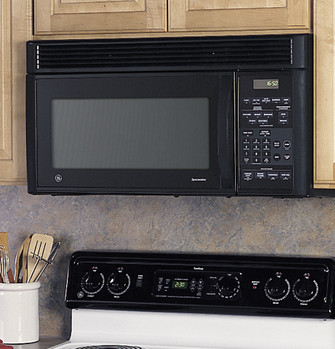
So what’s my complaint? It’s this: it seems to me that as long as the user control panel and display are working, the product should be designed to show some basic error codes. I checked online and found no hidden key sequence that would unlock and activate this function. Simple numerical codes could show, for example, “door not latched” or “magnetron not working.” That would make basic troubleshooting much easier.
I’ll be frank: a non-working microwave oven is not a crisis in the bigger scheme. Still, I felt obligated as an engineer to see if the problem could be found and fixed without too much hassle or cost. If I failed, it would still be a learning experience.
I was optimistic since the vendor thoughtfully included a schematic diagram (Figure 2) and a wiring diagram (Figure 3) behind the easily removed user front panel; both are relatively simple. Suppose you’ve ever done any troubleshooting of a system or product with multiple assemblies and components. In that case, you know that the schematic is an essential “conceptual” diagram, but the wiring interconnection diagram is even more useful as it details the physical connectors and cabling. Still, these diagrams were of limited help in linking symptoms and possible causes here.
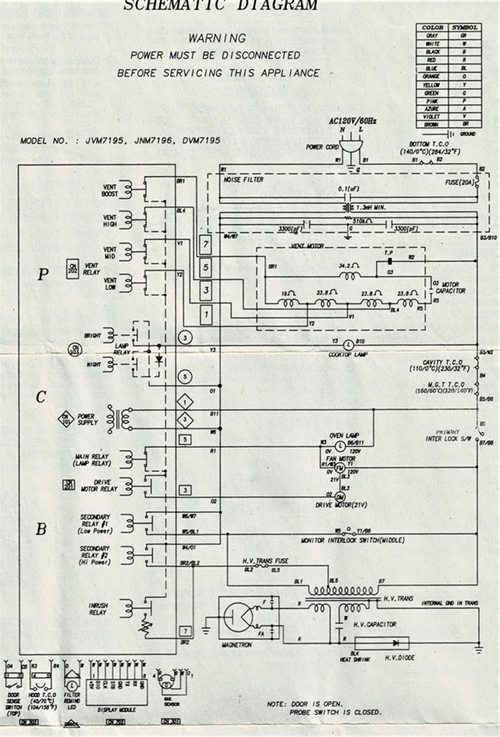
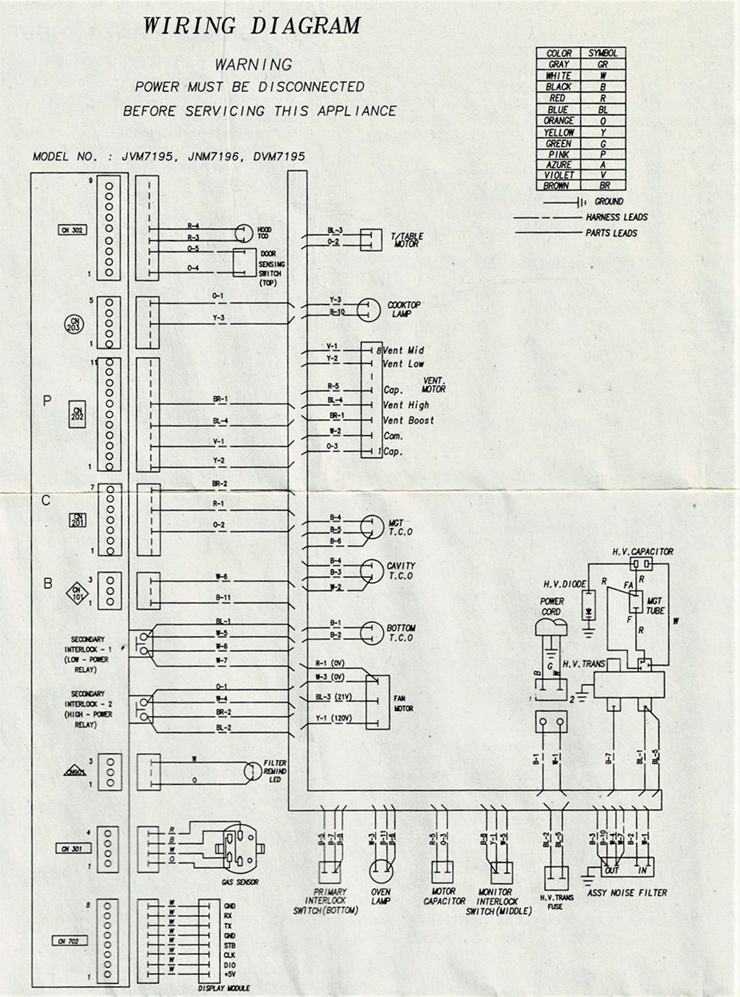
A simplified system-block diagram — even one of a generic unit — is also nice but really not critical (Figure 4).

Unfortunately, the schematic shows the all-important control board as a single block with no details (Figure 5). According to a footnote on the schematic, that board contains the power relay, vent blower TRIAC, surface-light relays, microcontroller, and other components.
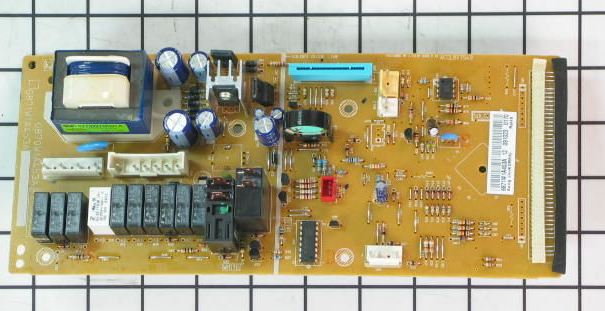
While I couldn’t find a schematic of the control board or a code listing, I really didn’t need those, nor could I use them. But at this point, I was just curious to see what was on that complicated board. I did find a schematic, bill of materials (BOM), source code, and additional details on how to build your similar board from “scratch” (Figure 6, and Reference) — which I strongly recommend not doing due to the inherent nature of these units with their high voltages, magnetrons, magnetics, microwave RF emissions, EMI/RFI emissions. and other “nasties.”
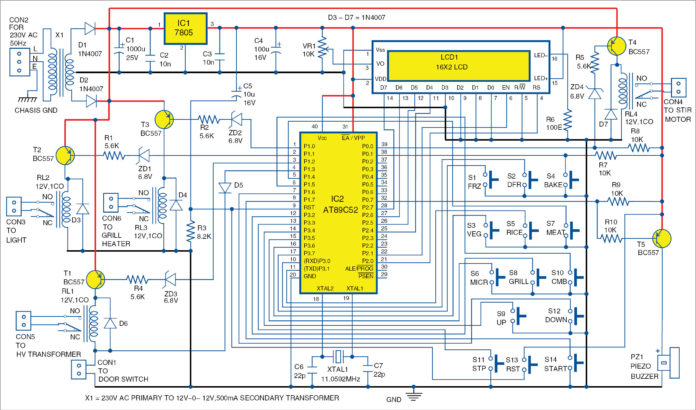
Of course, I also checked online and found some useful fix-it-yourself videos done by apparently knowledgeable repair people. However, several of these otherwise insightful videos were somewhat misleading, as they said to check all the fuses for continuity – that was easy enough and made sense. But they said that any fuse that tested open had blown, and so was the likely source of the problem. That was wrong for two reasons.
First, is pretty rare for a fuse to blow by itself, so you need to find the real problem that caused it to open. Further, my study of the schematic and other research showed that one of these “fuses” they checked was actually a thermal-activation fuse that is normally open (NO), not normally closed (NC). It closes only when the cooking range immediately below the microwave oven gets too hot and so turns on the vent fan, which is built into the bottom of the microwave oven. So if it checks out as “open,” it is actually OK and has not blown.
I’ll spare you the details of the various troubleshooting scenarios I went through. At different points, I was “pretty sure” I had identified the problem: bad fuse, bad fan, bad magnetron, bad connectors, bad door-interlock switches…the list went on. Unlike some consumer products, many of the components in this oven are available and replicable at a modest cost.
My final assessment is that one of the critical interlock switches that ensure the door is fully latched before allowing the magnetron to activate was either defective or misaligned. That was the problem: in order to confirm each supposition, I would need to buy spare parts and replace them one at a time. Going through all of them is a serial, time-consuming cost, and it adds up. Furthermore, you don’t want to be poking around a microwave oven with a voltmeter.
So why no error codes? I realize that some components, such as fuses, are difficult to monitor. But the status of others is known to the system microcontroller. I’m wondering if the designers of this oven decided error codes would be too much effort to add or require a few extra kilobytes of memory. Or was the intention to make the average homeowner say, “the heck with it,” and just replace the entire unit? Is it to reinforce the message “no user-serviceable parts inside?”
Ironically, the oven itself is fairly easy to disassemble, and most of the components have easily removable clip-on connectors, so replacing them does not seem too difficult. For example, the magnetron is a standard item, costs about $75, and takes about an hour to replace. Or perhaps I am simplistic, as they may be safety and regulatory mandates which make repairing such a product legally, if not technically risky?
In the end, I decided to not spend any more time on trying to fix this unit due to the hassle of getting and trying spare parts, the challenges of working on this sort of appliance, and the genuine electrical, RF, and other risks involved. Sometimes you have to swallow your pride, be prudent, and move on.
I realize that there are situations where error codes aren’t going be available, such as when the control board itself is bad (not in this case) or when your PC is totally frozen, and you can’t run diagnostics (we’ve all been there). But it is certainly unfortunate to have what is likely a modest repair effort be stymied by the lack of basic operational diagnostics. As far as I can tell, there’s no legitimate reason not to have some — or perhaps am I missing something here?
Related EE World Content
Magnetron, Part 1: Application and operating principles
Magnetron, Part 2: History and future
Up close and personal with magnetrons
Confused about RF-band letter designations? That’s not surprising!
Patrick Blackett: Big Data, WWII, and U-Boats, Part 2: Analytics begins
How to electrocute yourself in a few easy steps
What are RF waveguides? Part 1: context and principles
Basics of waveguides, microwaves, and ovens
Fuses, eFuses, thermistors, and fusible resistors – which and when?
Reference
Electronicsforu.com, “Microwave Oven Control Board”

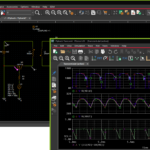
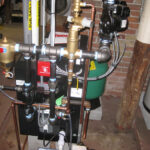
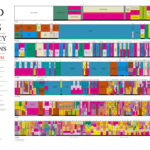

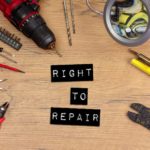

gee Bill error codes would make it easier to fix the product…..I suspect that’s why they don’t have them. when they did have them as you probibly know they where rather useless some times it was like opening pandora’s box or, told you nothing like the codes panasonic and other used to throw for their plasma sets which often had you looking in an area of end result instead of at the source.
a
further to my comment this fault is an easy one to figure out . #1. if the control board is following the inputs and the magnetron relay clicks when you press start then the board is working (generally) ordinarily when you press start and the relay engages the magnetron will start, this will make a fairly quiet sound sort of like a zzzzb lasting about a second then going quiet. This indicates that the magnetron is supposed to be producing power, but in the 30 yrs I have been servicing them I have allways been able to tell a weak magnetron by the sound it makes when it starts. That zzzb gets a little quieter and never really stops making that zzz noise when it is faulty or weak as the time for the startup goes by. Typicalls it sounds like it’s not quite firing up. I think it should be mentioned that microwave ovens can be lethal when the HV cap is charged as the result of a faulty bleed resister usually included interally . If it has blown a fuse like you said,there is a reason for that and the fuse didn’t go by itself although possible in rare occations. This is typically the result of a shorted diode on the HV cap. As a rule one should discharge that HV cap before attempting service on any microwave. These things mentioned here are for your readers and not specifically for you and it should be stated that a microwave should always allways be leak checked since the end result of leaky door seals or other leaks will result in a burn that doesn’t show up right away and isn’t painfull, this I know first hand thanks to a coworker using a micro to heat his lunch with-out a door seal and with me sitting at my bench 10 feet away unknowingly getting the burns.
Well Bill, your article makes me wish I had done some investigating when my LG microwave oven died in 2020. After it failed, the microwave was just a clock. The fix? We had a tabletop microwave that we pressed into service. That was 2020 when we were locked down. A few months later, our old “GE” dishwasher left water in the tub after running. I tied a few simple things to fix it but none worked. Now with two dead appliances, I figured it was worth replacing both. The goal was to buy from a single local dealer (not a big box chain store) and have them both installed at the same time. This was August 2020 and we really didn’t want people coming in but now, we had to. We bought both on “tax free weekend” over the phone, which saved some money. Wanting just one delivery, we had to wait until both were in stock. The new microwave is indeed at “GE” because that was what we could get. Maybe your article will come in handy in a few years.